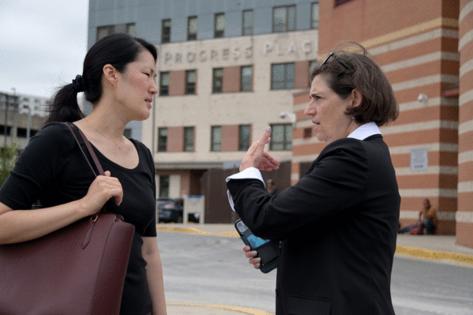Maryland clashes with Trump on homelessness, could see influx from DC that would strain shelters
Published in News & Features
SILVER SPRING, Md. —The encampment near the Kennedy Center in Washington, D.C., was cleared of its homeless residents last week, leaving brown patches in the grass outlining, like shadows, the spots where their tents had stood.
It wasn’t clear where the dozen or so members of the makeshift tent city — as well as many more displaced in President Donald Trump’s push to send homeless people “far from the capital”—would go.
Many could end up in Maryland, advocates for the region’s homeless population say, straining county budgets and shelters already at capacity. Among those bracing for a possible influx is the state’s largest county, Montgomery, which says its 10 shelters are already full.
Montgomery County has about 1,200 homeless people, most of them in shelters, according to Christine Hong, who oversees the county’s homelessness services. She said about 150 to 170 are unsheltered on a given night. The county’s annual homelessness services budget, excluding state and federal funds, is $83.8 million. Hong said the county doesn’t yet have a sense “of the numbers we may see coming from the District.”
The Democratic-run state is an important player in the ongoing drama not only because it borders Washington but because its approach to homelessness differs markedly from that of the Republican Trump, who has equated homelessness with crime and says it could turn the capital “into a wasteland.”
The White House told The Baltimore Sun in a statement that it isn’t abandoning the homeless but rather “cleaning up D.C. to make it safe for all residents and visitors while ensuring homeless individuals aren’t out on the streets putting themselves at risk or posing a risk to others.”
‘Meeting the need’
Montgomery County commits to not allowing any family with a minor child to live on the streets, said Kate Stewart, the county council president. When the shelters are full, the county puts families up in motels, said Stewart, who called Washington’s homeless sweeps “just outright cruel.”
“Our work is very much about meeting the need, and it’s fluid,” said Hong. “The federal government deciding to clear encampments in the District is a major factor and that’s why we’re tracking the data very closely.”
D.C. crews, some arriving with bulldozers and dumpsters, have accelerated sweeps of the camps since Trump announced a crime and homelessness crackdown on Aug. 11, using federal authority after declaring a “crime emergency” in the city.
Homeless people “will have the opportunity to be taken to a homeless shelter or receive addiction and mental health services,” White House spokesperson Abigail Jackson said.
Maryland officials say Trump’s approach doesn’t address big-picture issues such as a scarcity of affordable housing.
“Clearing homeless encampments and displacing unhoused individuals is not a strategy to reduce homelessness,” the state Department of Housing and Community Development said in a statement to The Sun on behalf of Gov. Wes Moore’s administration. “The current level of funding in most communities is not enough to serve the existing unhoused population, and any additional burden on this already strained system means that more people will go without shelter and housing.”
Maryland closed a $3.3 billion deficit this year with tax increases and spending cuts, and the state is projected to have deficits each fiscal year through at least 2029. Federal cuts could also take a toll on future budgets.
From the District to Maryland?
The state could be a favorable destination for people uprooted in the District, said Claire Wilson, executive director of Georgetown Ministry Center, which offers a drop-in center and other services in Washington.
“If I know an area is going to provide a robust set of services and treat them with dignity and respect — that they are as deserving of as anybody else — then I would absolutely recommend it,” she said.
Wilson said she was trying to help those displaced on a grassy stretch of land on Aug. 14 near the U.S. Institute of Peace and the Kennedy Center:
“We just couldn’t even get there in time. And it was really heartbreaking to see the bulldozers come and just flatten their areas,” she said.
Washington’s Health and Human Services department, which oversees the sweeps, said in a statement on its website: “Our protocol for cleaning public spaces is triggered when a site presents a security, health, or safety risk. We provide resources to shelter, pathways to housing and access to behavioral health services to individuals at these locations.”
Wilson said some from the encampment may walk across one of the Potomac River bridges into Virginia to find a new space, while an unknown number may head to Maryland.
Others, Wilson said, will try to stay in Washington. “Whether they are housed or unhoused, there is a community that they’re connected to, services they’re connected to. It’s not as simple as telling people to leave the District,” she said.
‘We can’t do it alone’
Montgomery County’s 10 shelters include six dedicated to individual adults, three for families and one for people fleeing domestic violence. The county is investing $6.9 million this year for a program called Short-Term Housing and Resolution that offers rental assistance to help families transition into homes.
Hong was interviewed near a drop-in center for the homeless called Progress Place, which is tucked in behind a fire station in Silver Spring. On a recent afternoon, some drop-ins mingled on nearby sidewalks. A day care center across the street prominently posted a “Private Property. No Trespassing” sign on a high fence in front of a play area with tire swings and basketball hoops.
As it monitors its homeless population, the county is in touch with Washington, Prince George’s County, Frederick County and Charles County — as well as other jurisdictions in Maryland and Virginia — to try to coordinate responses.
“I think it’s safe to say that everybody is incredibly worried about what is happening,” said Hilary Chapman, the housing program manager for the Metropolitan Washington Council of Governments, a nonprofit that brings the governments together to address regional concerns.
Stewart, the council president, said: ‘We have to face the reality that we can’t do it alone. We need to work with our regional partners in this area to make sure people are getting the services they need.”
©2025 The Baltimore Sun. Visit at baltimoresun.com. Distributed by Tribune Content Agency, LLC.







Comments